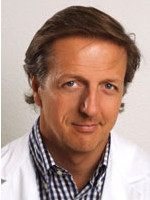All you need to now about Polycystic Ovary Syndrome
This disorder called PCOS, occurs in every fifth woman and is believed to be the most widespread barrier for natural pregnancy. The problem is that cysts can appear in the ovaries without any signs or symptoms. Rare sign is an intensive pain in the lower abdomen and it can be an alarming symptom, which may signal of cyst rupture or other severe complications. The ovum with cysts is not able to produce an egg, which leads to infertility of a woman.
Annually about 20 000 of women with ovarian disorders come to Germany for treatment. German fertility centers apply the multi-level, interdisciplinary and holistic approaches, which make the therapy especially soft, natural and efficient. New medications help in 80% to launch the natural revitalization process and normalize the hormone profile. Minimally invasive procedures are reserved only for those cases when medication has proved to be not efficient enough (it occur in >20% of all cases). Highly important is to schedule your visit to a trustworthy specialist timely in order to confirm the diagnosis, start the appropriate therapy and avoid the complications.
What are the causes and symptoms PCOS?
These two questions are most frequent during the consultation with fertility doctors. Cysts are liquid-filled sacks on the ovaries. These sacks are oversized follicles with microscopic eggs in them.
- Problems with follicle stimulating hormone: PCOS is usually caused with a hormonal imbalance between your pituitary gland and your ovaries. Pituitary gland produces follicle stimulating hormone (FSH). If the production of FSH is insufficient, the ovum produces pathological follicles, which cannot maturate and produce oocytes for further fertilization.
- Estrogen imbalance: PCOS occurs in many cases due to estrogen disorders. If the body produces too much estrogen, ovaries will build more than two follicles. Extra follicles may then convert to cysts. Also high insulin may be a trigger of pathological syndrome. Special medication can help in this case to normalize estrogen level.
- Insulin imbalance: Higher level of IGF (insulin growth factor) in blood test is a troubling sign, which may lead not only to pathological syndrome, but also to such a severe condition as Type 2 diabetes. Weight gain often occurs in this type of syndrome. Medication therapy is a must in this case.
- Stress is a risk-factor: Too much stress is considered to be a risk factor for PCOS. Stress and anxiety boosts androgens level, which also leads to polycystic disorder.
Accurate diagnostics in Germany is a key component for PCOS management
The German fertility specialists are usually guided with the following criteria in diagnostic. They are: ovulation disorders, higher testosterone level, ovum with pathologic appearance (determined during the ultrasound control). The 4-Step diagnosis procedure is indicated in case of PCOS suspect:
Step 1 for diagnosing PCOS: Gynecological examination and symptom discussion helps to form a preliminary view of the hormonal status of the woman. Test for stretching of cervical mucus.
Step 2 After the primary examination a sonographer (ultrasound) procedure should be made. Modern ultrasound diagnosis helps to visualize the ovaries and tubes and study them in different projections. Diagnostic criteria of polycystic syndrome are: the volume of the organ, diameter of ovarian capsule, hyperplasia, the presence of more than 10 follicles (cysts) in diameter up to 10 mm. The high information content and availability of ultrasound makes it an indispensable tool for the diagnosis of polycystic ovum.
Step 3: transvaginal study with special microcamera, which is introduced through the cervical canal (laparoscopic diagnostics)
Step 4: The next stage of diagnosis of PCOS is paraclinical (laboratory) method. For typical polycystic ovarian hormonal studies following results are relevant:
- luteotrophic hоrmone (LH)
- increased ratio of LH / FSH
- Increased concentration of testosterone
How are patients with PCOS symptoms treated in Germany?
Patients with PCOS are treated individually, since they need to be very carefully managed. The most recent developments in German reproductive medicine make the treatment of polycystic ovum syndrome soft and efficient.
Conservative (medication) therapy of PCOS is performed using the hormone drugs of new generation, which help
- to level side-effects
- to decrease the hormone level
- to rule out ovarian failure
- to achieve the awaited pregnancy
German specialists try to achieve the therapeutic result as quick as possible. For this reason German clinicians are offering new medication types, which are thoroughly tested and then applied for treatment.
- Metformin is a new medication, which is sometimes prescribed to women with polycystic ovum disorder in Germany. This medication improves body’s response to hormones and reduces the insulin level.
- Modern oral contraceptive medication helps to regulate the menstrual cycle and to reduce the risk of uterine cancer, which is associated with hyperstimulation of uterine lining due to hоrmone disorder.
The medication for PCOS treatment is always chosen individually, proceeding from your individual needs and diagnosis results.
Laparoscopic treatment of PCOS: If polycystic syndrome proved to be resistant to medication, the German specialists recommend a minimally invasive (laparoscopic) procedure. Laparoscopy is conducted in order to remove the cysts, which don’t response to medication. To improve the efficiency of this treatment method, German fertility specialists use an integrated approach of conservative and surgical therapy.
Pregnancy chances after treatment of polycystic ovum disease are twice as high as before the therapy. Usually patients are able to conceive a child in the next six months after the laparoscopic treatment of polycystic ovaries at German fertility centers. For more information about clinical experience, successful pregnancy rates and the best German, Austrian or Swiss fertility physicians, specializing in treatment of polycystic ovary syndrome, call us or write an E-mail.
















 Loading ...
Loading ...


